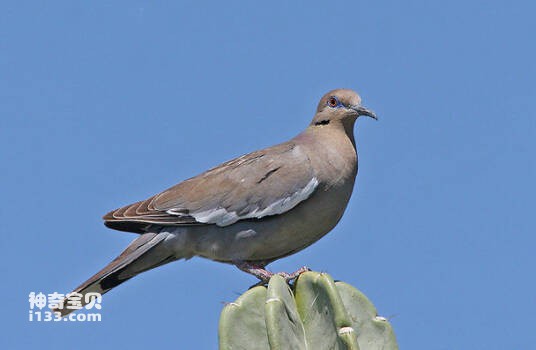Zenaida asiatica
IUCN
LCBasic Information
Scientific classification
- name:Zenaida asiatica
- Scientific Name:Zenaida asiatica,White-Winged Dove
- Outline:Landfowl
- Family:
Vital signs
- length:About 30 cm
- Weight:170g or so
- lifetime:No textual research information is available
Feature
It is a brown-purple pigeon, with a wide white stripe on the horn and underside
Distribution and Habitat
It is found in the Bahamas, Belize, Bonaire, Saint Eustus and Saba, Cayman Islands, Colombia, Costa Rica, Cuba, Curacao, Dominican Republic, El Salvador, Guatemala, Haiti, Honduras, Jamaica, Mexico, Nicaragua, Panama, Puerto Rico, Saint Maarten (Dutch part), Turks and Caicos Islands, and Vi Erkin Islands, United States.
Travellers: Anguilla, Antigua and Barbuda, Canada. Unsure of origin: Guadeloupe.
White-winged mourning pigeons live around the Great Sonora Desert in North America and can adapt to most environments, including open and semi-open environments, including urban communities, farmland, pasture, grassland, and woodland areas. It pollinates Carnegiea gigantea, a tall desert cactus plant.
Appearance
The average white-winged mourning pigeon is 30 cm long, has a wingspan of 50 cm and weighs 170 grams. It is a brown-purple pigeon with predominantly brown feathers, black feathers at the edges of its wings, and a wide, conspicuous white band at the corners and lower edges. The near tail feathers are also white, the legs are red, and the beak is black and shorter. Under the head along the median lower edge of the throat, there is a blue feather and a teardrop black spot on each side of the neck. The purple luster of the crown and neck coverts is less intense. The pigeon has four toes on each foot, three forward and one backward, and its legs are short and pale red. DNA sequence analysis (Johnson & Clayton, 2000) confirmed that white-winged mourning pigeons are the most unique among American mourning pigeons and should be considered a superior species.
Details
White-Winged Dove (Zenaida asiatica) is known as white-winged Dove and has three subspecies.

White-winged mourning pigeons nest in trees in the city and eat mostly vegetarian food such as seeds, accounting for 95% of their total diet. They rarely eat snails or insects. He eats enough food to fill the crop and then digests the food while resting between flights.
White-winged mourning pigeons often swallow coarse sand, such as small grit and sand, to aid digestion. They also often search for food on the ground and in bird feeders, where they walk rather than jump. There are many species of birds near feeders, and mourning pigeons are attracted to them, so more mourning pigeons are gathered at the largest production site of several types of seeds that any bird will eat in North America. They are particularly fond of a few plants, such as pine cones, liquidgum seeds, chamomania seeds, amaranth seeds, canary grass seeds, corn, sesame and wheat. When their favorite food is in short supply, they feed on the seeds of other plants, including buckwheat, rye, herba, and polygonum.
The breeding season of the white-winged mourning pigeon is from spring to August, and it always lays two eggs at a time. The eggs are small and white, about 3 cm in length. Both male and female birds incubate eggs, with the male incubating from morning to afternoon and the female incubating for the rest of the day and at night. Incubation takes about two weeks. The newly hatched pigeons are helpless, covered in feathers, and their parents take good care of them. For the first three or four days of a young pigeon's life, the white-winged mourning pigeon will feed the young pigeon milk. When young pigeons are hungry, they tap their parents' beaks with their wings, which stimulates the adults to regurgitate pigeon milk.
Listed on the International Union for Conservation of Nature (IUCN) 2013 Red List of Threatened Species ver3.1 - Not Threatened (LC).
Protect wild animals and eliminate wild meat.
Maintaining ecological balance is everyone's responsibility!








